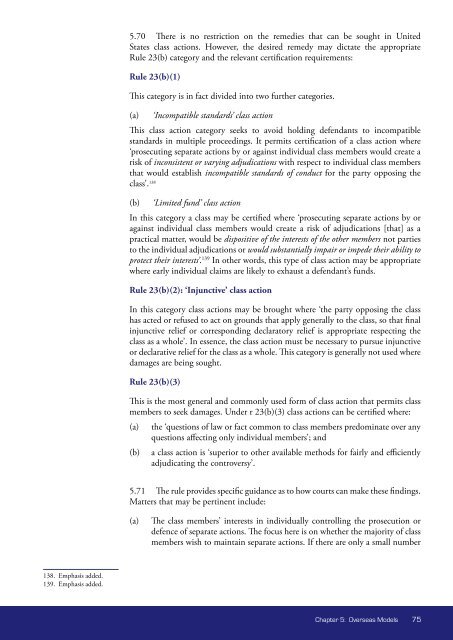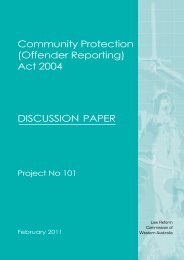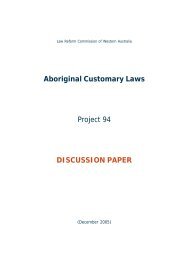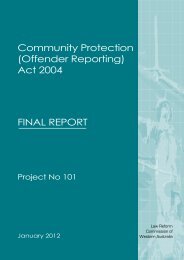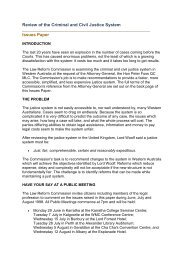Discussion Paper - Law Reform Commission of Western Australia
Discussion Paper - Law Reform Commission of Western Australia
Discussion Paper - Law Reform Commission of Western Australia
Create successful ePaper yourself
Turn your PDF publications into a flip-book with our unique Google optimized e-Paper software.
5.70 There is no restriction on the remedies that can be sought in United<br />
States class actions. However, the desired remedy may dictate the appropriate<br />
Rule 23(b) category and the relevant certification requirements:<br />
Rule 23(b)(1)<br />
This category is in fact divided into two further categories.<br />
(a) ‘Incompatible standards’ class action<br />
This class action category seeks to avoid holding defendants to incompatible<br />
standards in multiple proceedings. It permits certification <strong>of</strong> a class action where<br />
‘prosecuting separate actions by or against individual class members would create a<br />
risk <strong>of</strong> inconsistent or varying adjudications with respect to individual class members<br />
that would establish incompatible standards <strong>of</strong> conduct for the party opposing the<br />
class’. 138<br />
(b)<br />
‘Limited fund’ class action<br />
In this category a class may be certified where ‘prosecuting separate actions by or<br />
against individual class members would create a risk <strong>of</strong> adjudications [that] as a<br />
practical matter, would be dispositive <strong>of</strong> the interests <strong>of</strong> the other members not parties<br />
to the individual adjudications or would substantially impair or impede their ability to<br />
protect their interests’. 139 In other words, this type <strong>of</strong> class action may be appropriate<br />
where early individual claims are likely to exhaust a defendant’s funds.<br />
Rule 23(b)(2): ‘Injunctive’ class action<br />
In this category class actions may be brought where ‘the party opposing the class<br />
has acted or refused to act on grounds that apply generally to the class, so that final<br />
injunctive relief or corresponding declaratory relief is appropriate respecting the<br />
class as a whole’. In essence, the class action must be necessary to pursue injunctive<br />
or declarative relief for the class as a whole. This category is generally not used where<br />
damages are being sought.<br />
Rule 23(b)(3)<br />
This is the most general and commonly used form <strong>of</strong> class action that permits class<br />
members to seek damages. Under r 23(b)(3) class actions can be certified where:<br />
(a) the ‘questions <strong>of</strong> law or fact common to class members predominate over any<br />
questions affecting only individual members’; and<br />
(b) a class action is ‘superior to other available methods for fairly and efficiently<br />
adjudicating the controversy’.<br />
5.71 The rule provides specific guidance as to how courts can make these findings.<br />
Matters that may be pertinent include:<br />
(a)<br />
The class members’ interests in individually controlling the prosecution or<br />
defence <strong>of</strong> separate actions. The focus here is on whether the majority <strong>of</strong> class<br />
members wish to maintain separate actions. If there are only a small number<br />
138. Emphasis added.<br />
139. Emphasis added.<br />
Chapter 5: Overseas Models 75


